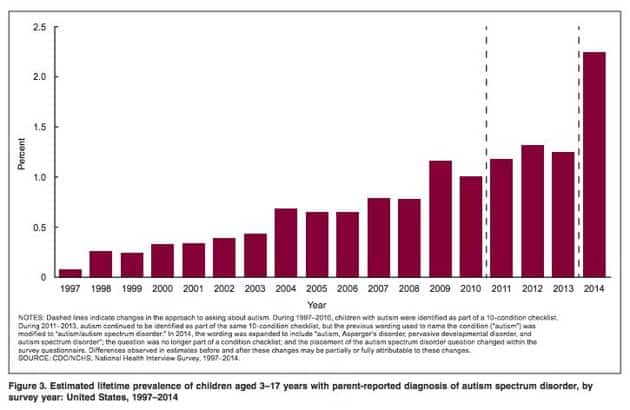
According to the U.S. Centers for Disease Control and Prevention, autism spectrum disorder has doubled in the last year. That means now 1 out of 50 kids has autism in comparison to last year's 1 out of 100.
National Health Statistic Reports
Defining autism
So what's caused this drastic change? It turns out this increase is likely due to the adjustment of the questions asked in the survey. The new questions allow for a broader definition of the disorder.
Autism spectrum disorder encompasses a myriad of social and developmental challenges from mild to severe. According to Health Day,"Several different conditions are considered autism spectrum disorders, but they share some common features. They're characterized by difficulty communicating and interacting with others socially, as well as patterns of behavior that are very repetitive and often impaired, compared with what is usually seen in an age group."
The diverse symptoms and types of autism mean that survey respondents-parents of kids with autism-may have had difficulty accurately responding to questions in past years. However, this problem isn't uncommon or solely an issue with these types of surveys. Because data needs to be easily quantifiable, survey makers have to use a few categories to define a wide range of responses. This can result in answers that are misunderstood or not absolutely accurate.
Changing the question
That's why this year the survey was changed to get a more complete picture. Chief psychiatrist and medical director of Children's Health Council in Palo Alto, California Dr. Glen Elliot said, "Probably the most important finding of this paper, which is hardly new, is that how one asks a question matters."
So, due to the new way the survey asks questions, it's likely there are not actually more kids with autism but the parents of autistic children are only now reporting their children's disorders.
Seeing the impact
At the end of the day, the doubled numbers aren't anything to panic about. The purpose of these types of surveys is to make sure children are getting the care they need. An accurate understanding can make a positive difference in the lives of families dealing with these issues.
For example, Elliot stated, "The diagnosis of autism spectrum disorder could have a profound impact if insurance companies are compelled to cover services for toddlers and even older children." But these benefits extend beyond insurance. This report can help schools better understand the needs of their students and provide for them. Furthermore, these new numbers can inspire additional research and justify funding.
While we might not have a good idea about whether or not autism is increasing or not, changing the definition can have a positive impact on the way these kids are cared for.
So, maybe it's a good thing the numbers doubled.


